The Definitive Guide to Optimizing Conversion Rate
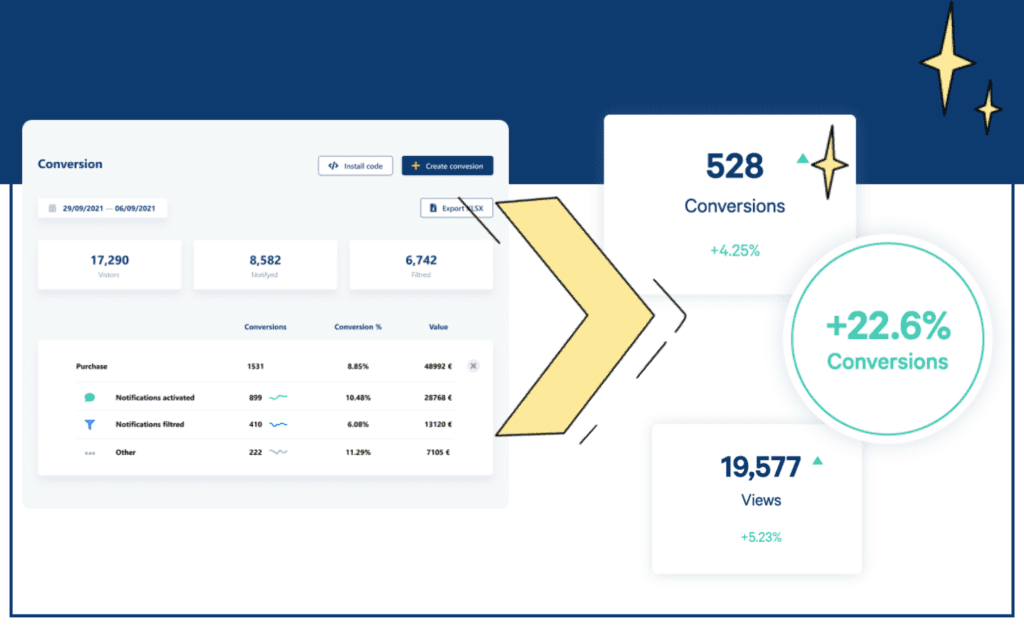
Have you ever wondered what CR, CRV, CRO, CTR, CPL, CPC, SEM, ROI (to name a few.... ) are and how they matter to your business?
Me too. I got tired of not being 100% sure what people are referring to in meetings when these acronyms come up.
1. Have you been in a similar situation?
I didn't dare to ask anyone what on Earth they were talking about, so I did my research and decided to share my findings with others. Now you don't have to go through the trouble of googling and reading everything there is on this topic, as I've summarized it for you.
If you want to understand what conversion rate is and why it matters,
You’re in for a treat, as the following article will:
- demystify the acronyms
- Explain how they are relevant for your business
- Showcase good conversion rates from different businesses
- Help you control and improve them
Once you understand how conversion rate works, you’ll be able to:
- Create more effective marketing campaigns
- Track your campaign performance
- Minimize ad spend
- Maximize your sales
Off we go!
1.Demystifying the Most Used Acronyms
Here's a quick overview of the most used acronyms that are related to conversion rates. After the list, I'll provide you with some examples of them to deepen your understanding. There's an own section dedicated to conversion rates and optimizing them, but I'll quickly introduce other relevant terms as well, because you need to understand what they mean in order to improve your conversion rate in the future.
Acronyms Explained
| Acronym | Stands for | Tells you | How to calculate |
| CR | Conversion Rate | How many people have acted based on seeing your ad | Actions / ad interactions |
| CVR | Conversion Rate | How many people have acted based on seeing your ad | Actions / ad interactions |
| CRO | Conversion Rate Optimization | Refers to the process of increasing your conversion rate on your website or app | – |
| CTR | Click Through Rate | How many times someone has clicked on your ad vs. how many people have seen it | Clicks / impressions |
| CPL | Cost Per Lead | Measures how cost-effective your marketing campaigns are. | Marketing spend / total number of new leads |
| CPC (or PPC) | Cost Per Click (Pay Per Click) | Determines costs for showing users’ ads on search engines | Total ad spend / number of clicks |
| SEM | Search Engine Marketing | Companies pay for their ads to appear as search results | – |
| ROI | Return On Investment | How profitable your investments are | Total profit - marketing costs / marketing costs x 100% |
| KPI | Key Performance Indicator | How well you are doing on a specific department/task | – |
| SEO | Search Engine Optimization | SEO aims to get more of your potential customers to find you by using search engines | – |
Click Through Rate (CTR)
CTR can be used to figure out how well your keywords and ads are performing. It's calculated by taking the number of clicks a specific link has and dividing it with the number of people that saw it.
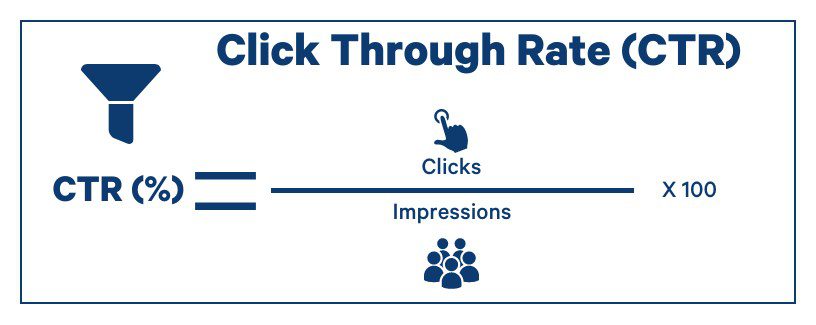
It's commonly used to measure online ad campaigns and the effectiveness of email campaigns.
For example, if you have a 60 clicks on one of your banned ads and 10.000 people have seen it, your CTR for that would be:
60/10.000 x 100%= 0,06%
CTR is a simple metric to use to track how many people you have been able to direct to your site. Anything that happens (or doesn't happen) after you have the people on your site is related to conversions.
Cost Per Lead (CPL)
Measures how cost-effective your marketing campaigns are.
Wikipedia's definition of CPL is: "CPL is an online advertising pricing model, where the advertiser pays for an explicit sign-up from a consumer interested in the advertiser's offer."
To simplify, CPL refers to how much money you have to spend to get a single lead. CPL doesn't take into account how many clicks your ad has had, but focuses on how many people converted by, for example, submitting their email address to a form.
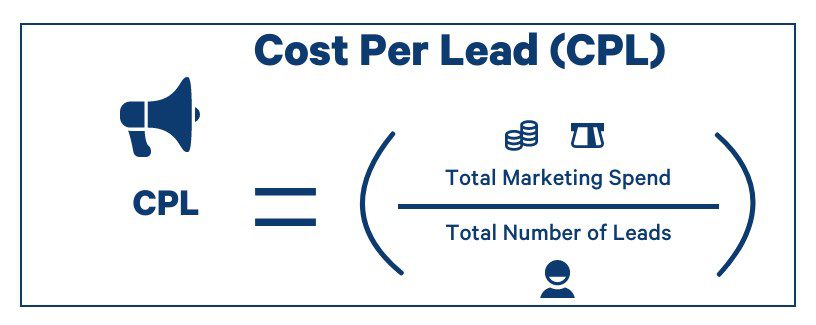
You can calculate your CPL by taking your total marketing spend and dividing that by the total number of lead you got.
Cost Per Click / Pay Per Click (CPC / PPC)
Cost Per Click and Pay Per Click are synonymous and they refer to the cost of getting a single click on your ads on search engines, social media platforms and all other platforms.
This is a very common online advertising revenue model which is mostly used by advertisers that have a set daily budget for a campaign. Once you've reached your daily budget, your ad will automatically be removed from that website's rotation for that billing period. In other words, you won't exceed your budget.
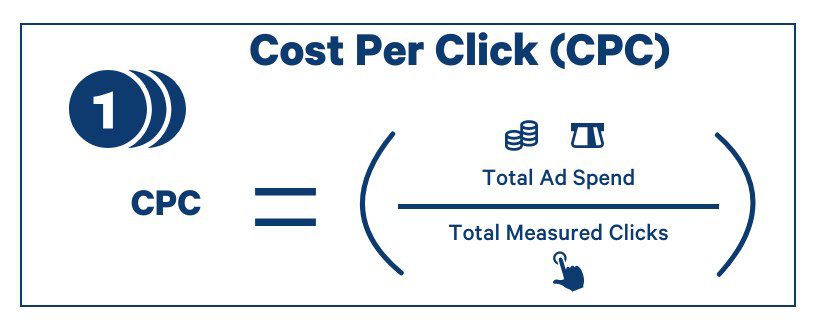
You can calculate your CPC by taking the total ad spend and dividing that by the total number of clicks.
The problem with this model is that you can't really make sure beforehand if you are getting quality clicks that will then also convert once they've clicked the ad. This model is also prone to have at least some accidental clicks, and each click costs you money.
Search Engine Marketing (SEM)
Search Engine Marketing refers to a model where someone is paying search engines (such as Google) to increase their search visibility. Companies pay for their ads to appear as search results on the top of search engine result pages (SERPs).
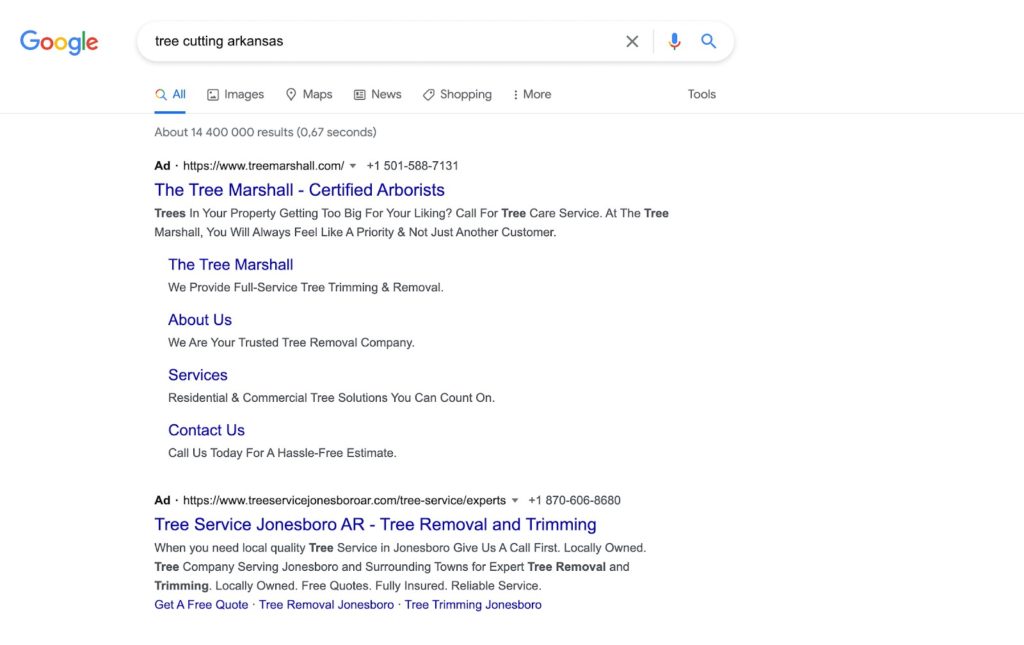
Notice those little "Ad" marks? Yup, these aren't organic search results, but paid ads. These companies have paid Google for certain keywords. When these paid target keywords are are googled, BAM, the ad pops up.
Return On Investment (ROI)
ROI in laymen terms= How much money you spent is compared to how much profit you made with that spending.
In marketing terms, this translates to tracking how much you're spending in ads and how much those ads are creating profit.
ROI Formula:

So:
- Add up how much money you got at the end
- Subtract the marketing costs from that to get the
- Divide that by the marketing costs
- Convert into a %
The higher your ROI is, the better you are doing. The only way you can start improving your ROI is to keep a close eye on your conversion rate.
Key Performance Indicator (KPI)
You can measure your non-financial performance with Key Performance Indicators. Even though they don't have a monetary value, they heavily contribute to the company's overall profitability.
In the marketing context, KPIs are measurable factors that are tied to specific objectives of a marketing campaign. They are used to track progress during a marketing campaign and to measure the overall effectiveness of that campaign.
Some KPIs of marketing:
- Number of new customers
- Customer lifetime value
- ROI on ad spend
- Cost per lead
- Conversion rates
To summarize: Setting and tracking KPIs help you create strategic marketing campaigns and evaluate the results.
Search Engine Optimization (SEO)
Search Engine Optimization refers to the process of improving the quality and quantity of the traffic to your website from search engines.
In English: By doing SEO, you aim to get more of your potential customers to find you by googling the products or services you offer.
Conversion rates are one metric to track while doing SEO. But before you can start doing SEO effectively (or at all) you need to understand what conversions are.
Here's our beginner's guide for doing SEO
Conclusion
There are many abbreviations to learn, but trust me: Once you start improving your marketing campaigns by implementing conversion tracking to the aforementioned aspects, you'll soon be a native in using them yourself.
As you are now familiar with the abbreviations I'll use them throughout this article. Since we now have the basics covered, it's time to dive right into the actual topic of the day – Conversion Rates.
2. Defining Conversion Rate
We've a lot of ground to cover, but let's start from the basic concepts and move on to the bigger picture.
We'll go over the following topics:
- Conversion Event
- Conversion Rate
- Conversion Rate Optimization
- The Importance of Conversion Rates
Conversion Event
First, we have to understand what a conversion event is. Conversion events refers to any action you want your website visitors to make.
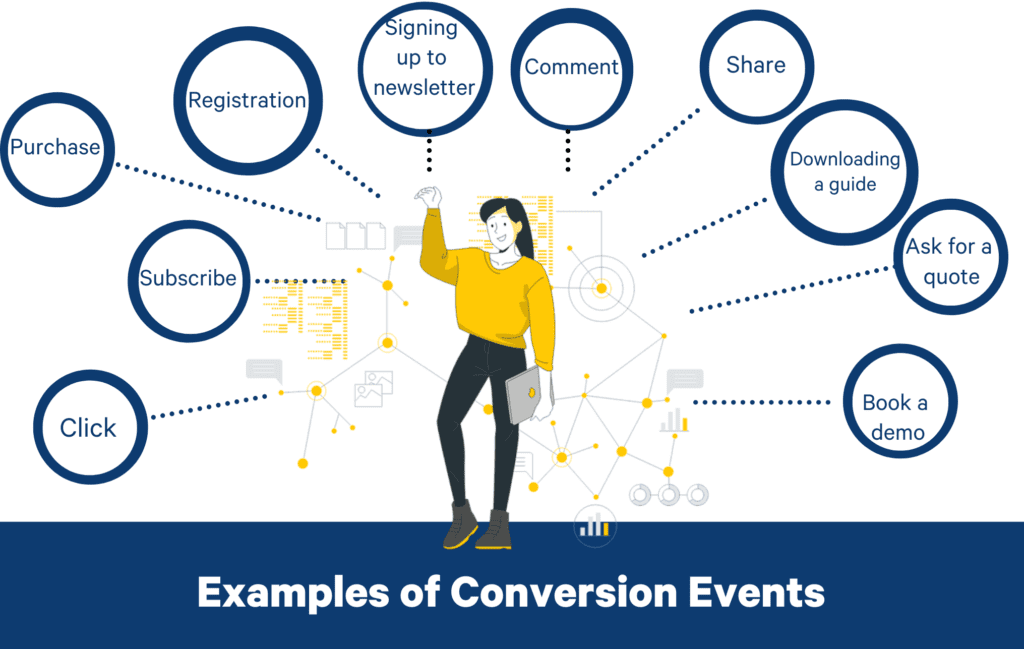
Examples of conversion:
- Purchasing from your online shop
- Registering to your site
- Signing to your newsletter
- Commenting a blog post
- Sharing your content in their own social media channels
- Downloading a guide you wrote
- Asking for a quote of your service
- Booking a demo
- Signing up for a subscription (free or paid)
- Watching a video you posted
- Clicking on an ad or even a link
- Reading an article you mention in your other article
The list goes on. To summarize, conversions aren't just doing sales or something directly related to it, but rather they are KPIs that are relevant for your industry and business model. For instance, retail businesses have very different goals than people selling online courses.
Conversion count means the number of times an action has happened. However, it's more important to focus on the conversion rate than on conversion count, because starting only at the conversion count might trick you.
For example, if you count how many times an ad was clicked, you'll lack the information what happens once people are on your website. This is what you should track and aim to improve. That being said, each conversion event can have their own conversion rates.
Conversion Rate (CR or CVR)
Conversion rate measures how effective a webpage, email or an ad really is. It tells you how many viewers or website visitors performed the desired action once they were exposed to your content.
Conversion Rate Optimization (CRO)
Refers to the process of increasing your conversion rate on your website or app.
The Importance of Conversion Rates
Conversion rate is a metric that will help you track, improve and speed up your growth.
By collecting this sort of meaningful data, you can start comparing and contrasting how your ad campaigns are performing in multiple advertising channels.
If you don't know what is working well, you can't repeat it let alone improve the results.
Optimizing your conversion rates will:
- Get you more sales with the same traffic
- Increase your ROI on paid ads
- Help you get more email signups and quote requests
3. How to Calculate Conversion Rate
Conversion rate can be calculated by taking the number of people that completed the desired action by the overall size of the audience. This number will then be converted into a percentage.
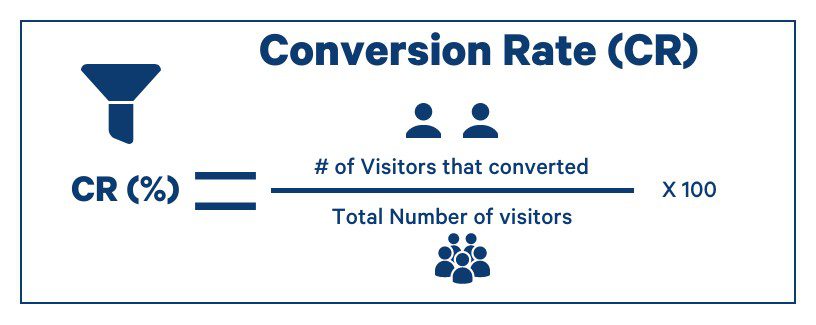
CRV = the conversions divided by the total visitors and multiplied with 100.
You can also see this number directly from your Google Analytics:
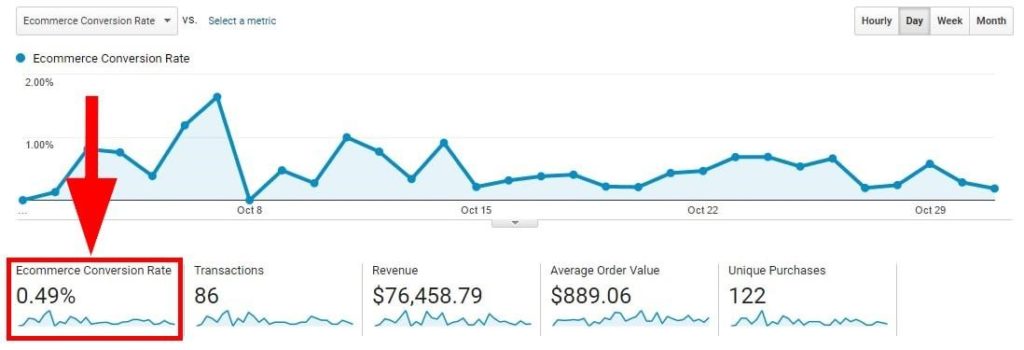
Who counts as a visitor?
Even though it might seem simple on paper, there are many scenarios you should consider before you start to track your conversion rate.
Let's look at an example:

Matt visits your site once while Amber visits five times within a week.
Ask yourself:
- Do we count unique visitors? In this case you'd have two.
- Do we count if the same user visits our site five times within the tracking period? Then you would have a total of 6 visitors, even though there are only two unique people.
Both are correct ways to go about it, and you are free to choose whichever works the best for you. You just have to remember to be consistent and count with the same logic every time.
One conversion event or all of them?
Another thing to consider is how to count users that are converting.
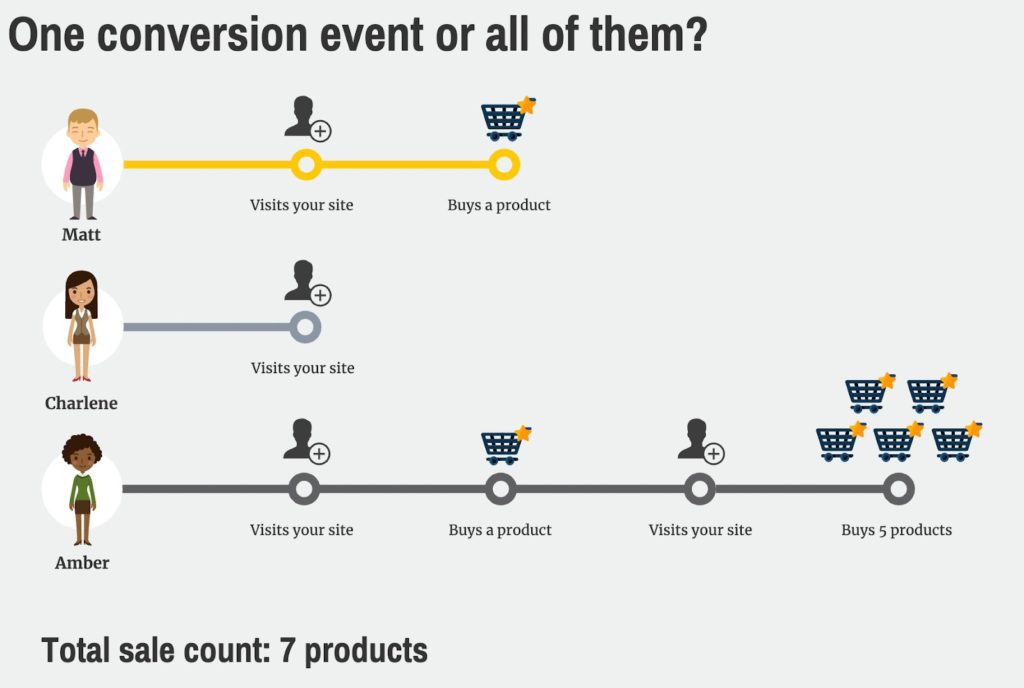
Matt buys one product from you, Charlene doesn't buy anything, while Amber keeps on ordering more and more stuff and ends up making six purchases during the month. At the end of the month, your total sales count is seven.
Again, you have two options.
- Count only unique persons (2 people bought, so two conversion events)
- Count each person as many times as they convert (1+ 0 + 6 purchases = 7 conversion events)
Feel free to choose either one of the options presented, but remember to use it consistently in all your measurements.
I Have My Conversion Rate. Now What?
Okay let's take an example:
You run an ad campaign on LinkedIn that reaches a total of 20.000 people. 500 people out of the 20.000 people clicked on the ad.
500/20.000= 0,025 --> Your conversion rate is 2,5 %
Now you have tested one ad which got a 2,5% conversion rate.
| Campaign | Number of clicks | Reach of the ad | Conversion rate |
| 500 | 20.000 | 2,5% |
Once you have your conversion rate for one ad campaign on LinkedIn figured out, you can start figuring out what works and what doesn't:
Launch the same campaign on different channels and compare results
This way you'll figure out what is the most cost-efficient channel to reach your target audience.
| Campaign | Number of clicks | Reach of the ad | Conversion rate |
| 500 | 20.000 | 2,5% | |
| 200 | 15.000 | 1,3% | |
| 800 | 80.000 | 1% |
In this scenario, I'd put more effort on LinkedIn than on Facebook, as there's a significant difference in the conversion rate.
Modify the campaign and run it again on LinkedIn
This will offer you insights on what works and what doesn't.
| Campaign | Number of clicks | Reach of the ad | Conversion rate |
| Campaign1- LinkedIn | 500 | 20.000 | 2,5% |
| Campaign2- LinkedIn | 100 | 5.000 | 2 % |
| Campaign3- LinkedIn | 600 | 10.000 | 6% |
Campaign 3 clearly outperformed previous campaigns, even though it reached less people than the first campaign. Now that you have the data, you can start drawing conclusions on:
- What is your target audience
- How to reach them
- How to motivate them to convert (=to do something)
- How to get better results with less effort
Conclusion on conversion rates:
Once you start measuring your conversion rates, you'll be able to analyze trends and to start improving your overall conversion rate. A higher conversion rate translates to more results with the same effort.
You can allocate the saved marketing resources to new and more effective campaigns to further boost your sales or direct them to other areas of your business.
As we're now experts on how to calculate conversion rates, let's now focus on increasing website conversion rates.
4. Actionable Ways to Increase Your Website Conversion Rate
This part will focus on CRO and the nine most effective ways of doing it in the modern digital marketing era.
1. Check Your Site Speed
Be honest: When was the last time you did this? Do it, for example, with Google's PageSpeed Insights. Now. The results will give you a baseline to start improving.
Here's an example how they may look like. The greener, the better.

People are busy and they'll quickly leave your page, if it isn't loading fast enough (= within a few seconds).
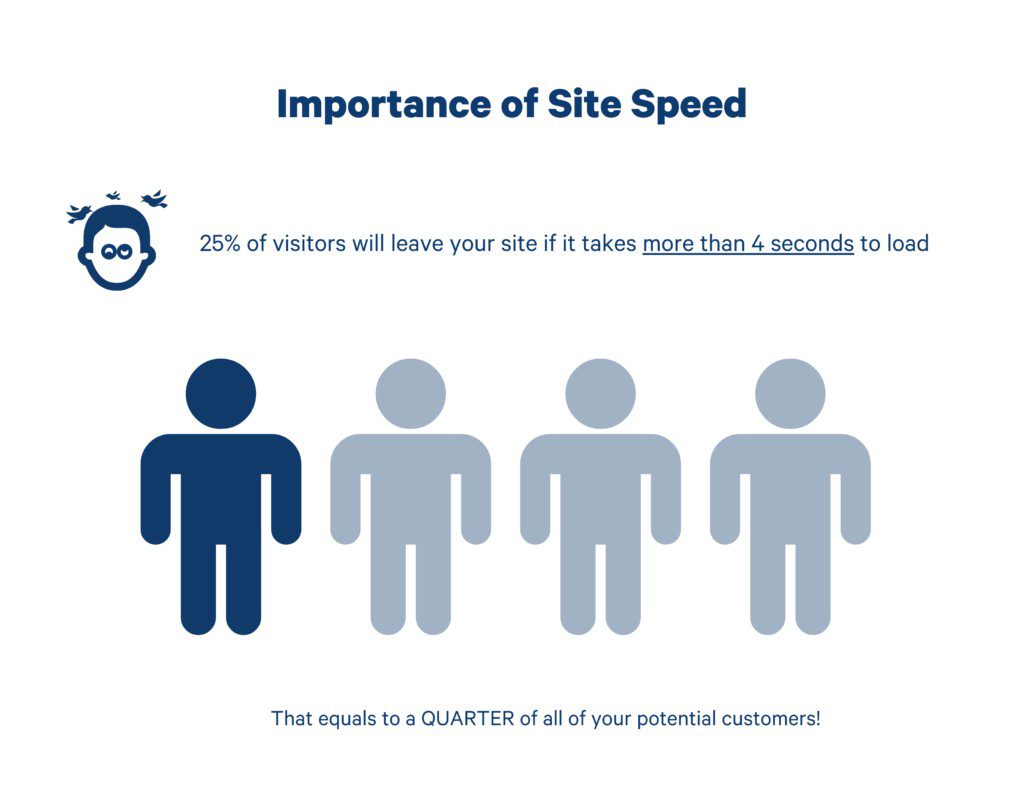
According to research, one in four visitors will leave your site if it takes more than 4 seconds to load. According to Portent, conversion rates drop on average by 4,42% with each additional second of load time during the first five seconds.
So: Optimize your site speeds to get more conversions. Here's one of our blog posts where you can find some additional information on improving site speed.
2. Run A/B Split Tests on EVERYTHING
Sometimes, it's the smallest things that bother us and make us leave a site without buying or signing up for a newsletter or discount code.
Such factors include:
- Your headline
- Font size
- Body copy
- Colors and icons used
You can run an A/B split test to test different versions of the same page, while only changing one aspect at a time.
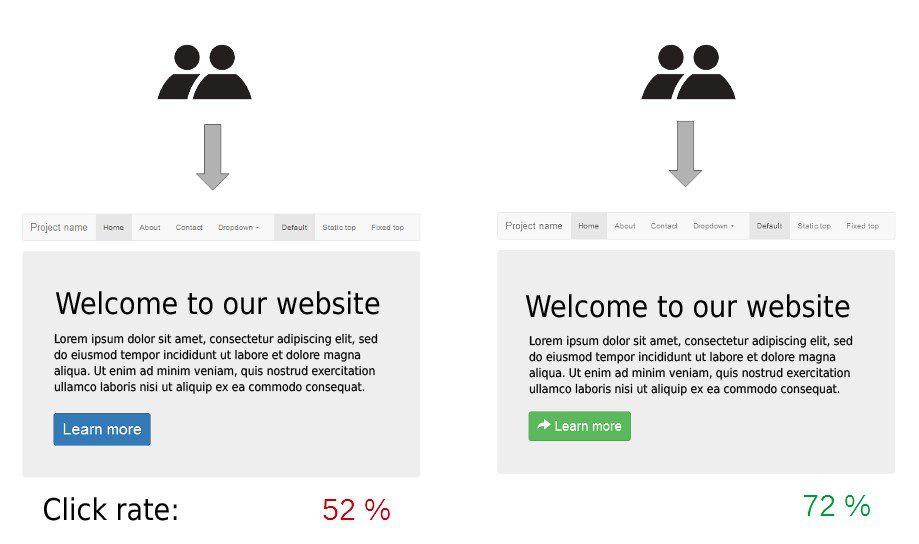
In this example, by changing the call to action button from blue to green an adding an arrow improved the click rate by 20%.
Even though doing A/B tests to each tiny variable might sound like tedious work (because it is), it's still worth the trouble. I'm not saying go through each tiny detail, but it's a good idea to test out at least some aspects which you might have overlooked before. You'd be surprised about which aspects actually make a difference.
What is the smallest and most surprising tweak you made that ended up making a huge difference in your conversion rate? Let me know in the comments.
I'm always baffled at how seemingly random details make a big difference.
If you're looking for an easy tool to do A/B tests, start your free 14-day Trustmary trial.

3. Audit Your Landing Page
As your landing pages are the pages you are directing people to and which are designed to convert visitors into leads, they need to be on point.
Try using an online tool to get a user behavior report of your site to gain insights on what your visitors are doing on your landing page.
Crazy Egg is a nice tool. It gives you a heat map of what the visitors are clicking on or browsing on your landing page.
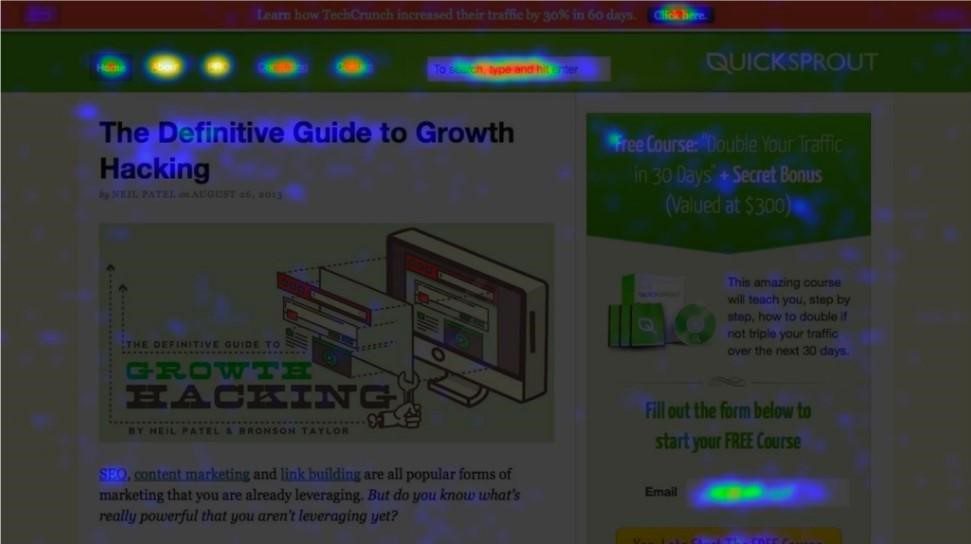
Once you know what they are interested in, you can try to improve conversions by tweaking the aspects you would like them to see.
4. Make Your Offer Clear
Which one sounds more appealing?
- If you want, you may get my e-book here.
or
- Download my free e-book on conversion rate optimization!
Don't be afraid to be clear about what you have to offer. The clearer your offer is, the more likely the right audience is to take on the offer.
After all, your products or services are developed to fulfill a very specific need. Be clear what that need is and how you are better than your competitors. That will for sure lead in a higher conversion rate.
5. Write a Blog (& Improve It!)
Blogs are a great way to offer your customer helpful and insightful content about your industry and the problems you solve. In addition, your readers can be turned into leads.
However, you shouldn't write a blog just because you hope it might improve your conversion rates. Write one, because you want to help and educate your site visitors. The results will follow. But only if you do a good job with your content.
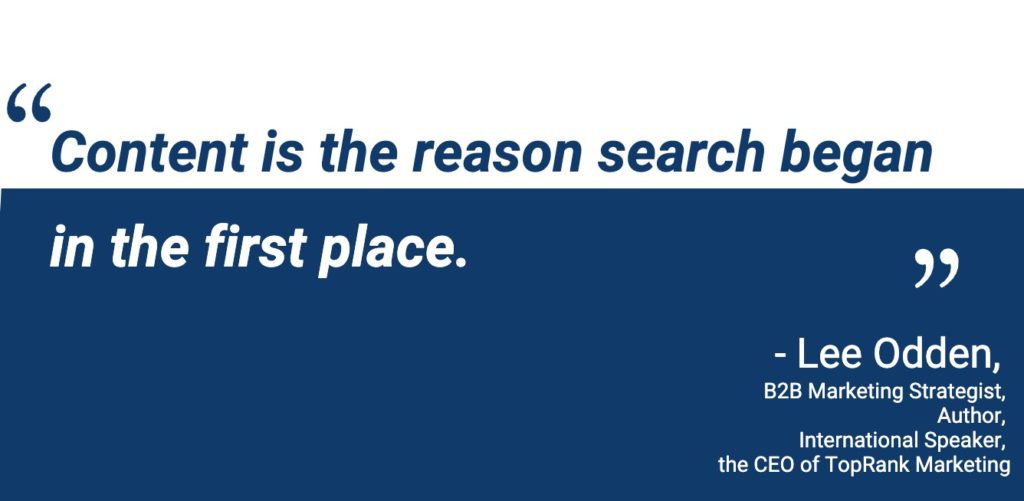
Never forget that "Content is the reason search began in the first place.” as said by Lee Odden, who is a B2B Marketing Strategist, Author, International Speaker, and the CEO of TopRank Marketing.
That being said, once you have published some blog posts, you should start tracking how they are performing
Track at least these to get meaningful data:
- CTRs – gets you an idea of which types of content generate and convert leads
- CVR – lets you know which posts turn visitors into leads or even customers
- Traffic source (organic, ads, social media, emails, ...)
Even though your CTRs would be through the roof, you need to make sure by tracking CVRs that those readers are becoming leads or customers instead of being just visitors. Once you have a baseline for both these metrics, it's time to start the improvement phase.
How to Get More Conversions from Your Blog
- Take the posts with most traffic, but lowest conversion rates and the posts with the least traffic.
- Analyze and improve SEO to get more traffic
- Update older posts with up-to-date information (it makes a huge difference to the credibility if something was written in 2011 vs. in 2022).
- Add pictures, infographics, gifs, videos, etc to make the post easily skimmable (so people see the call to action at the bottom of your post)
- Add call to actions and widgets throughout the post to increase conversion rates
6. Call to Action (CTA)
Call to action is a term used in the marketing world that refers to any design element that's purpose is to get the audience to perform a desired action immediately. In other words, to convert.Use CTAs to encourage people to convert immediately.
Some examples of CTAs
- Buy now
- Visit our site
- Subscribe to our service here
- Start your free trial
- Download a free e-book
- Click here
- Book a demo
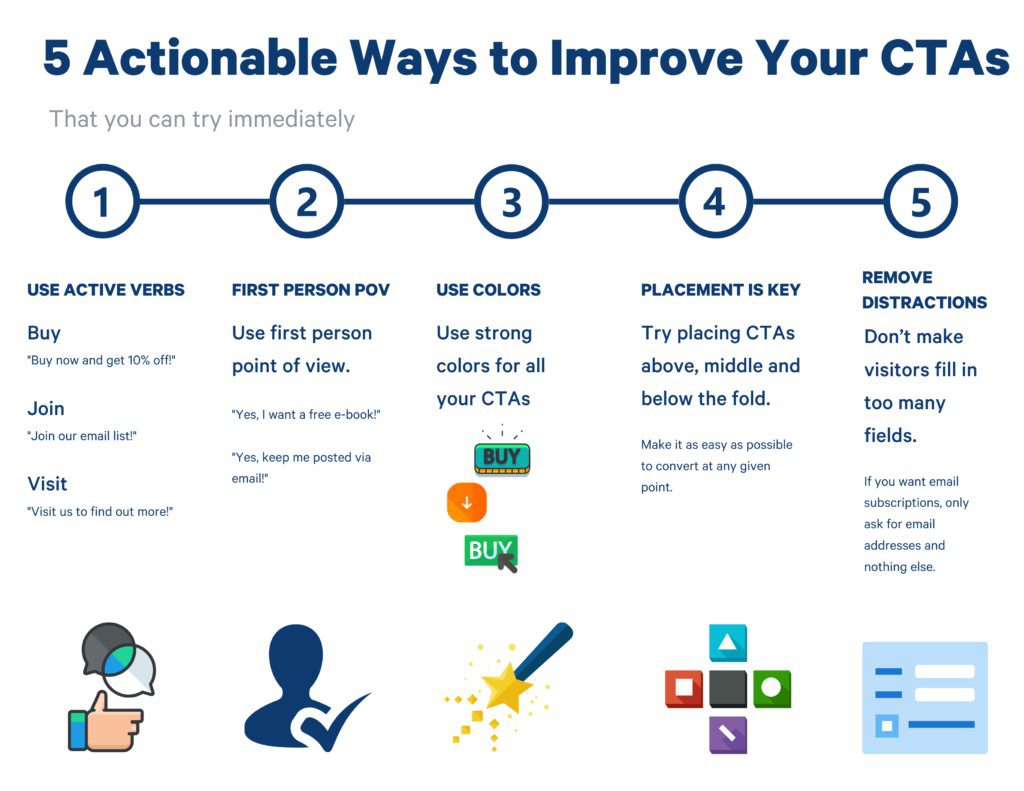
5 Actionable Tips for Improving your CTAs
- Use active verbs ("buy", "join", "visit" etc.)
- Try to use first person point of view ("Yes, I want a free e-book!" or "Yes, keep me posted via email")
- Use a strong color for all your CTA buttons
- Place CTAs both above, middle and below the fold (below the fold will most likely get you the most relevant results, but make it easy for your visitors to convert at any given stage!)
- Don't make visitors fill in too many fields. (Focus only getting emails, if your aim is to get email signups.)
These are simple tricks to maximize people's engagement to your site. No matter if you have a ecommerce site or a B2B service site, you need CTAs to make people convert.
CTAs may look different in mobile apps and on your mobile website, but they still work all the same.
7.Use Social proof to Build Trust
For people to give you their contact information (or more importantly, money), they need to trust you. The easiest way to improve your conversion rate is to increase your potential customers trust in you.
Start using social proof (=people tend to copy and follow the actions of others) by adding testimonials and reviews from your satisfied customers. Adding social proof to your site is one of the biggest impact factors in terms of conversion.
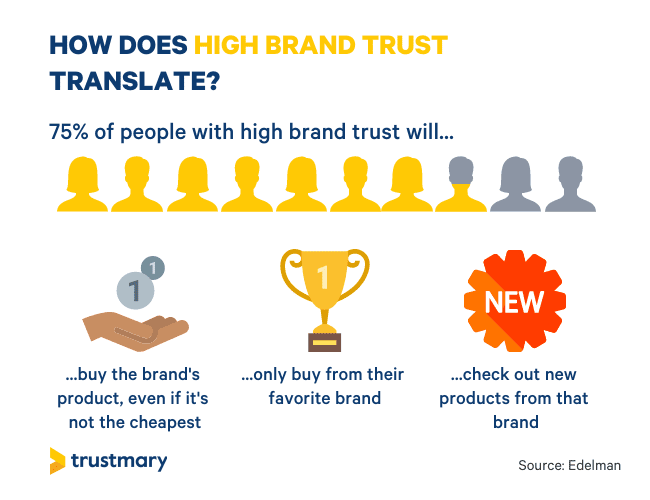
More Conversions with Testimonials (Simple 2-step process!)
- Determine your target audiences
- Analyze which types of users are coming to your website and from where. Some variables include location, gender, age, source they came to your site from. (Google Analytics is a great tool for finding out these aspects and many more)
- Create tailored review popups
- People only trust reviews that seem authentic and they feel like they can relate to the reviewer. To maximize your conversions, start showing your target audience reviews they find relatable.
- If you are a B2B business, add customer logos alongside with reviews as they increase the credibility even more.
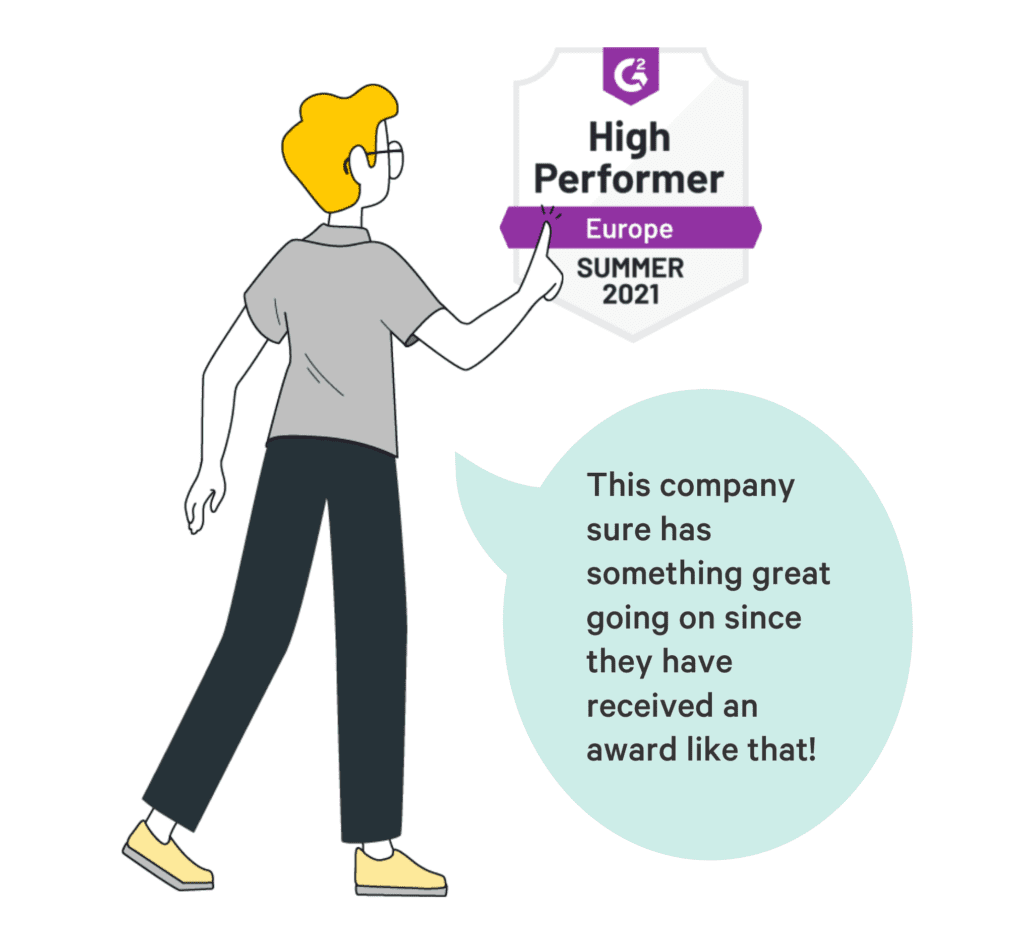
Example of How Social Proof Will Improve Your Conversion Rate
Peter lives in Philadelphia and is looking for a contractor to fix his roof. He googles "roof contractors in Philly" and finds options online.
- Company A states that they fix roofs and install windows in Philadelphia
- Company B says that they fix roofs in Pennsylvania
While Peter ponders which company he should request a quote from, a review popup from Company B appears on the lower left corner.
"Mike L. from Philadelphia just left us a review: "10/10, these guys really know what they're doing"
Even though Peter was hesitant at first, because company B said that they operate in Pennsylvania and not specifically only in his town, he was convinced after seeing a review from the same city. Peter goes directly to the "contact us" page of company B and fills in his contact information to get a quote from them. Because company A wasn't able to convince Peter in time, they were left without a conversion.
The same model works for all types of websites and services, but is especially crucial for tech companies. Use social proof and reviews to prove that your products or services create value and that you are a trustworthy company in the first place.
Don't Have Reviews to Publish?
If you haven't collected reviews and testimonials yet, start your 14-day trial with Trustmary now.
On top of getting reviews, using Trustmary enables you to:
- Publish the collected and on your website (with one click!)
- Create and publish tailored review popups to relevant target groups
- A/B test which popups work and in which context
8. Build urgency
"Grab yours now! Only 5 products left!"
"6 people are currently viewing the same hotel" (And there's only 2 rooms left with a lower price)
"Sign up before the group is full. Only 2 spots left!"
"You have only 4 days left to claim your exclusive discount code via email"
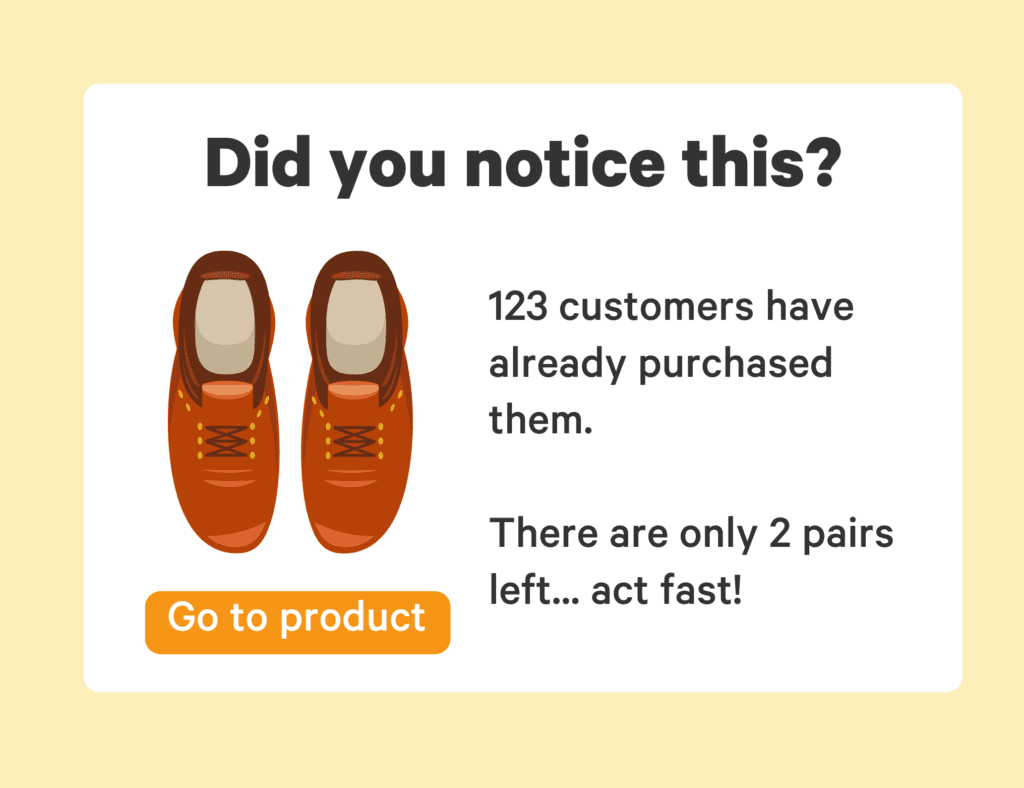
When was the last time you bought something or signed up simply because the offer had a time limit tied to it?
The magic of building urgency is that it makes people scared that they are missing out on something great. Each and everyone of us is constantly looking for the best possible deals. By creating a certain amount of urgency in your offer, you can significantly increase the chances of getting more conversions.
Try to make your offers be valid only a certain time and you'll be surprised how much revenue or results you'll create the closer you get to the expiration day.
9. Remove Distractions
Keep things simple and remove distractions. Make user actions as frictionless as possible.
This doesn't mean that you need to only have a "Buy here" button on your page, but aim to make your design user-friendly. Trust me, your conversion rate tells you exactly what works and what doesn't, so make changes accordingly.
How to Identify Distractions
- Review your entire website, page by page
- Use heat maps to see what people are doing on each page
- Critically evaluate all the links and content you have. (Is it motivating people to convert? If not, it's distracting.)
- Do A/B tests to see what effects removing something has
Conclusion on CRO
On the one hand, your website has one goal: Help you sell your products or services.
On the other hand, your website a an effective tool that can help your turn relevant visitors into customers later on, if they aren't ready to buy at that moment.
By optimizing your conversion rates, you'll enjoy the following benefits:
- Gain a better understanding of your customers
- Maximize your marketing spending
- Decision-making is based on marketing data instead of a feeling
- Creating a pool of potential customers you can market to (Will help tons, when launching new features or products!)
- Improved search performance
- Increase customer lifetime value
- Lower your customer acquisition costs
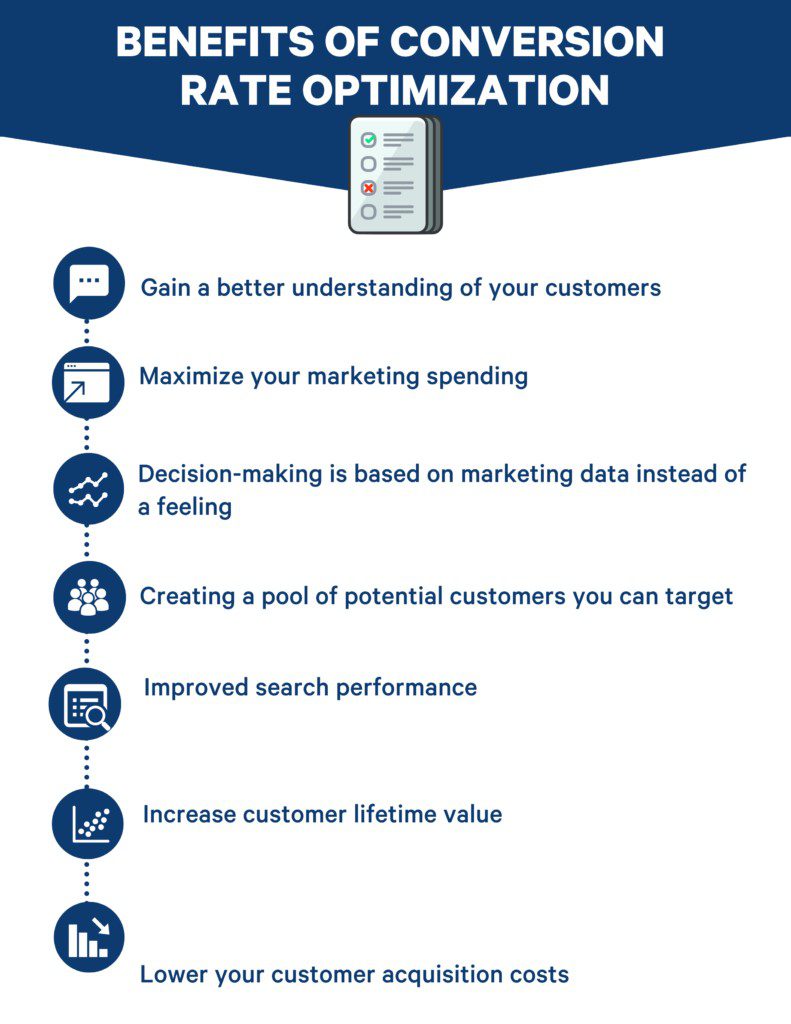
If you're looking for a sign to start making conversion rate records, this is it.
5. Industry Benchmarks of a Good Conversion Rate
A good conversion rate is very different for each industry. It depends on a vast variety of factors, such as:
- Industry your business is in
- Types of conversions that are typical (purchase, creating a profile, quote request, ,...)
- Source of the conversions (mobile app, website, social media,...)
- whether the conversion is free (subscribing to an email list) or requires money (buying a product)
Generally speaking, a good conversion rate = a conversion rate that is better than what it previously was. In other words, you're competing against yourself. Use your own previous results as a benchmark.
However, to give you an understanding of how well you're doing compared to your competitors, let's dig right in.
Overview of CVR by industry
Unbounce has used AI in their research to analyze more than 44.000 landing pages and over 33 million conversions. That has helped them to calculate some industry-specific averages (all CVRs combined and divided by their number) and medians (putting all CVRs to a line-up and taking the middle value) for conversion rates in 2021.
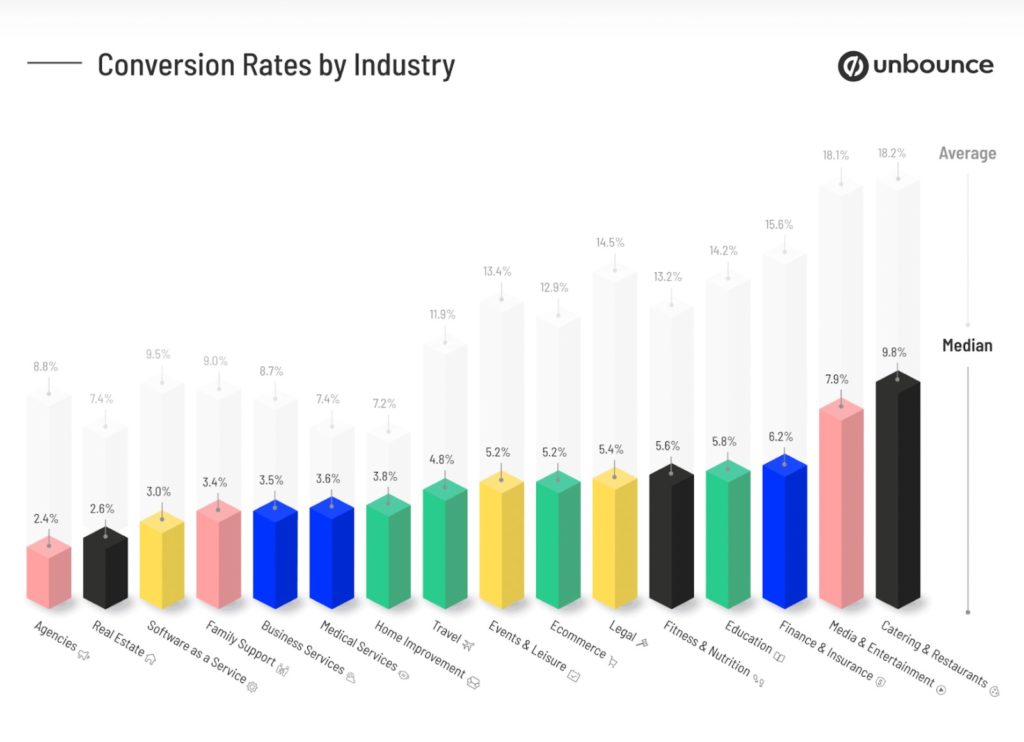
How do you rank up against some of these industries?
| Industry | Median | Average |
| Agencies | 2,4% | 8,8% |
| Real Estate | 2,6% | 7,4% |
| SaaS | 3,0% | 9,5% |
| Family Support | 3,4% | 9,0% |
| Business Services | 3,5% | 8,7% |
| Medical Services | 3,6% | 7,4% |
| Home Improvement | 3,8% | 7,2% |
| Travel | 4,8% | 11,9% |
| Events & Leisure | 5,2% | 13,4% |
| Ecommerce | 5,2% | 12,9% |
| Legal | 5,4% | 14,5% |
| Fitness & Nutrition | 5,6% | 13,2% |
| Education | 5,8% | 14,2% |
| Finance & Insurance | 6,2% | 15,6% |
| Media & Entertainment | 7,9% | 18,1% |
| Catering & Restaurants | 9,8% | 18,2% |
Below we'll have a look at some industries and their specific features in more detail.
B2B Websites
PropelGrowth set out to research what is a good conversion rate for a B2B business. Their method was to break down the funnel process based on lead qualification and to measure conversion rate in each step.
Steps of Lead Qualification:

Results:
- Inquiry to MGL = 5% conversion rate
- MQL to SAL = 60% conversion rate
- SAL to SQL = 50% conversion rate
- SQL to a win = 27% conversion rate
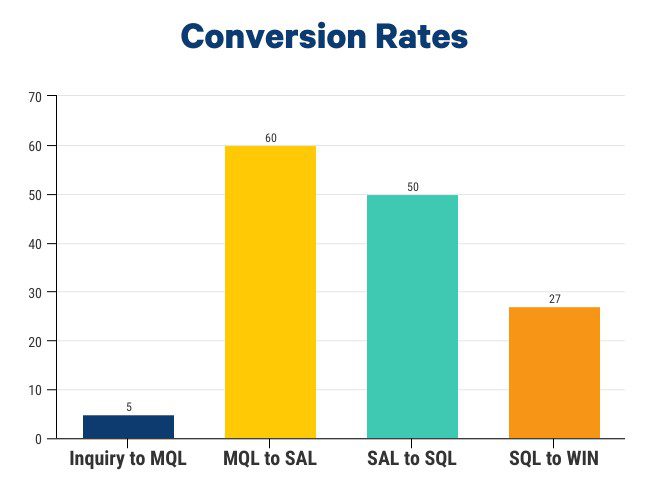
Due to the typical length and complexity of the sales funnels in B2B, measuring conversions should be done at each stage of the funnel to figure out what needs improvement. Furthermore, according to this data you should prioritize conversion rate optimization on prospects who are further down your funnel.
E-commerce websites
A 2017 Moz e-commerce benchmark study showed that the average conversion rate for e-commerce websites was 1.6%.
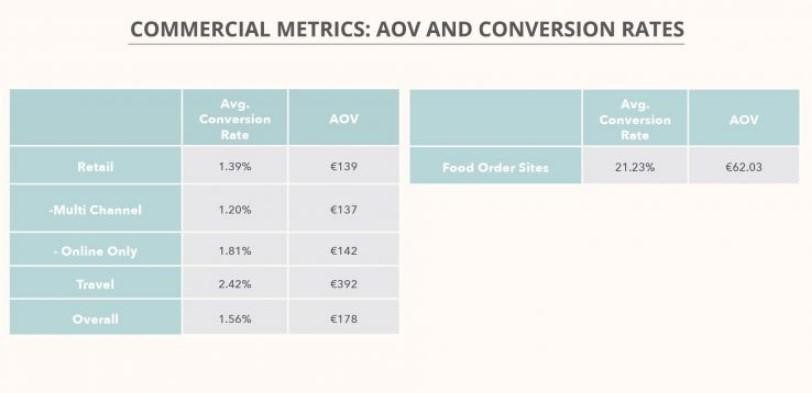
To understand this better let's break it down:
- 1000 visitors go to product page
- 16 of them make a purchase
- Conversion rate is: 16/1000 x 100% = 1,6 %
However, that 1,6% is only an average. It doesn't say anything about how many products the website has sold or how expensive the products are.
Landing Pages
A massive 2021 study of landing pages showed the median conversion rate to 16 different niche sectors. Across these sectors, the average median rate was 3,2%. The overall conversion rate average was 9,7%.
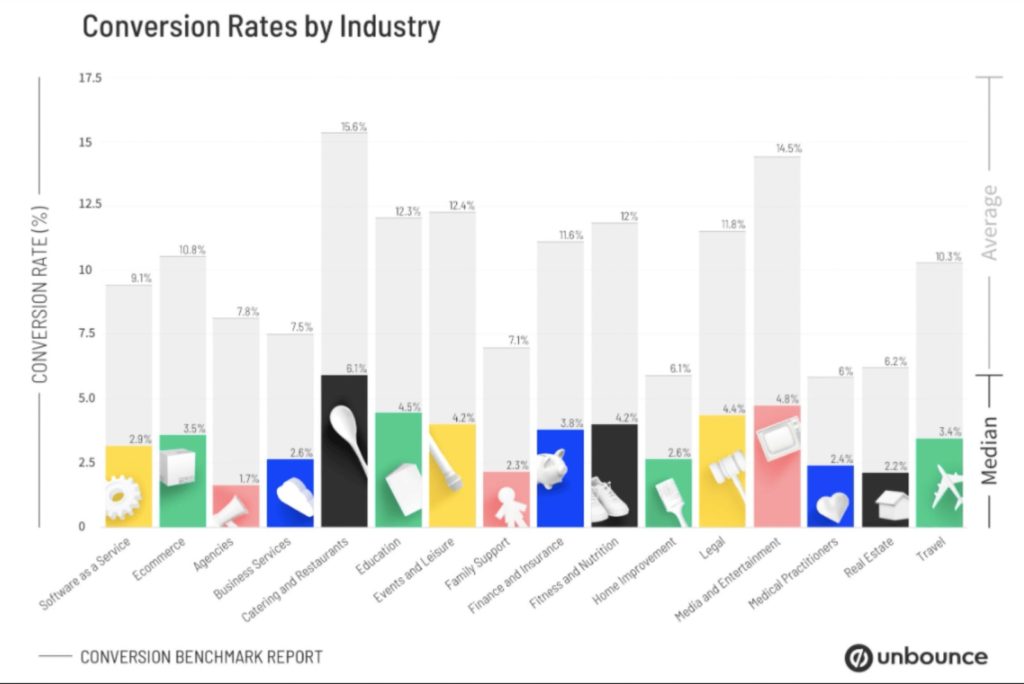
Such reports are highly valuable to marketing professionals that work in niche sectors, as they can compare their marketing data numbers to others in the industry.
It's important to take into account that the customer journey on each of these sectors is unique in both their length and complexity. Not every conversion will have an impact on your revenue in short-time thinking, but every conversion is a step closer to growing your business.
Facebook Ads
Wordstream did a study on Facebook Ads in 2021 and concluded that the average conversion rate for all industries was 9,21%.

The top three performers on Facebook are:
- Fitness (14,29%)
- Education (13,58%)
- Employment & Job Training (11,73%)
We can only guess what makes these three industries to be on top of the list. I'm fairly confident that it has to do with the fact that Facebook is a platform where people are easy to target thanks to the vast amount of information they've willingly added to their profile (full name, age, gender, location, former education, places visited, movies/tv shows/music genres they like,...). After all, Facebook is a social media that is used to stay connected to friends and acquaintances.
All of the industries that are doing well on Facebook Ads have been successful in tapping into this information probably by knowing their target audiences and developing great strategies for reaching them. Here's what to expect when doing Facebook ads.
Conclusion on average CVRs
Generally speaking, it's hard to define an average conversion rate for all industries. It's more beneficial to compare your conversions with your previous conversions than it is to compare your numbers against anyone else's. It's kind of like comparing a newcomer's revenue to the revenue of a global organization. What's the purpose?
After all, the way to grow is to concentrate your marketing efforts on CRO instead of comparing yourself against others.
However, we can draw some conclusions on average CVRs.

- E-commerce conversion rates are generally speaking a lower and they range between 1.84% and 3.71%.
- The average conversion rate across industries ranges between 2.35% and 5.31%.
- Average CVR for B2B varies between 2.23 and 4.31%
- Mobile app store pages perform significantly better than anything else and their average CVR is 26.4%.
Always keep in mind the following:
- Even though an average CVR for a certain industry would be high, it consists of all the CVRs which also include the lowest and the highest CVRs. The lowest might be 0,1 % and the highest 99%. You can't figure that out from looking at the average CVR, so don't be discouraged if your CVR is lower than the reported average.
- Many industries and companies don't publish their conversion rates at all. This might be, because they aren't tracking them at all or because they don't look too good. Reliable industry standards are hard to come by.
- Figure out what is your average CVR and work on that
Beware: Conversion Rates Can Be Misleading
You shouldn't blindly stare at your numbers and think they'll tell you the truth. They shouldn't be treated as the green light at the end of the dock, but more as a guide through the sea of marketing data.
Here are some aspects to consider before blindly trusting the number you see in your Google Analytics.
Traffic Source and Traffic Quality Affect Conversion Rates
It's a no-brainer that you should care more about the traffic quality and source than just the conversion rates. Don't focus on maximizing CRV at any cost, but rather on optimizing it.
For example, if your mobile app gets downloaded by potential users a lot but never used again, were those really worthy conversions?
After you've done some tests on your average conversion rates in different channels, you can better track what your ROI on them is. That'll help you determine whether you should focus on (or maybe even ditch) a specific marketing channel.
Instead of focusing solely on CRVs, your goal should be to increase the conversion rate of qualified leads versus any lead.
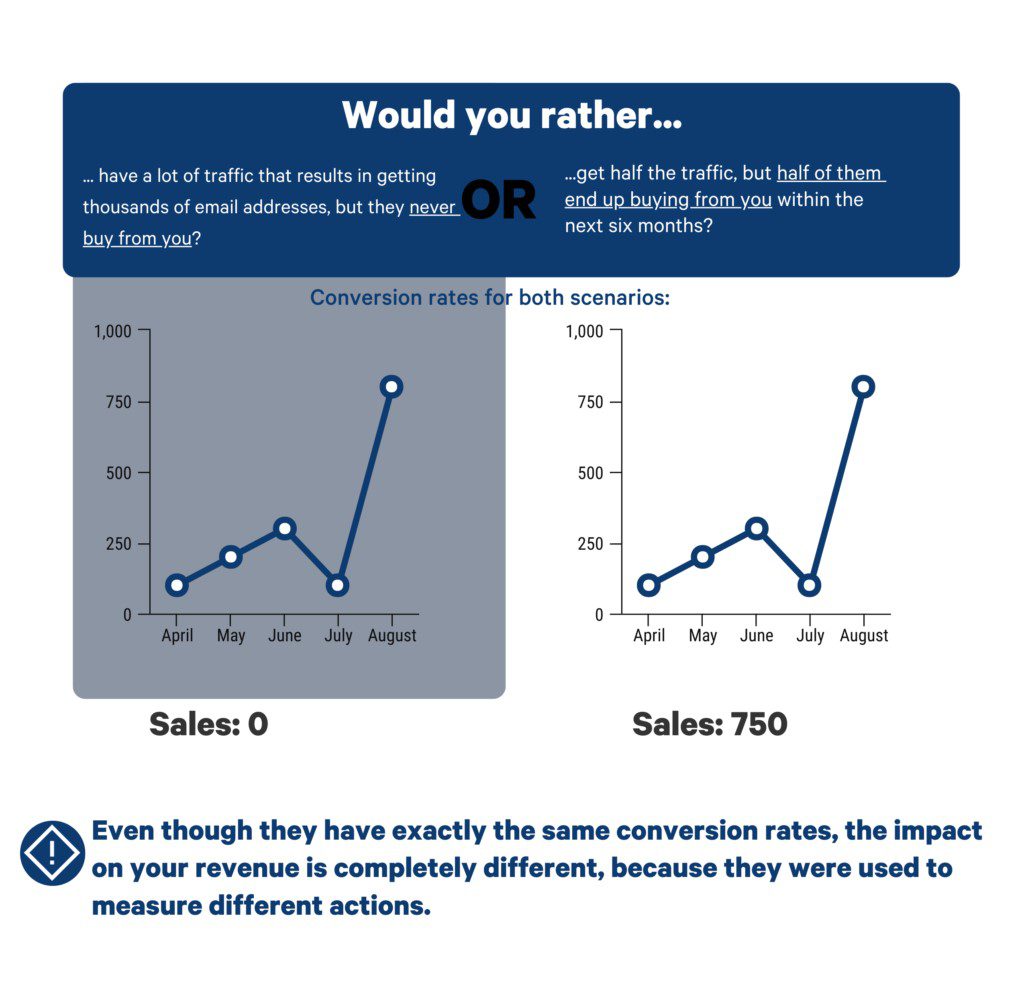
Would you rather
- have a lot of traffic that result in getting thousands of email addresses, but they never purchase from you
OR
- get half the traffic, but half of them end up buying from you within the next six months?
Even though these scenarios would have the same exact conversion rate the impact on your revenue is completely different. Focus more on your ROI (conversions are a part of that) than only staring at CVRs.
Seasonal changes
Always consider what kind of seasonal aspects influence your business in general.
I'd reckon it's pretty hard to sell snowboarding gear in the middle of the summer no matter how optimized your website is. Seasons often have a direct impact on the number of people
a) visiting your site
b) converting from visiting
For B2B businesses, there usually is a drop in sales and conversion before major holidays. No-one wants to add to their already full schedules, but rather we try to tie any loose ends before the vacation starts.
Don't be discouraged, if your conversions drop during a certain period. Before you start A/B testing like never before, check the following things:
- How are my sales in general this time of the year?
- How many users have visited during the last month?
- What kind of conversions did I have last year at this time?
It might be that your services or products just aren't in high demand during a certain season.
If that is the case, you have three options:
- Develop your business by inventing and launching new features, products or services that work around the year
- Go on a vacation when business is slow anyways
- Optimize your conversion rate in reasonable limits
Doesn’t take into account value of different customers
If you could decide, which customer would you want to get?
Customer A brings you 3.000€ during the next five years.
Customer B brings you 6.000€ during the next year.
Customer C brings you 8.000€ during the next five years.
I'd personally take Customer C and aim to increasing their lifetime value even more during those years they are my customer. Customer Lifetime Value (LTV) is a term that refers to how valuable each customer is during their entire relationship with you.
But how is LTV related to CVRs?
Well, that's the thing. It isn't. And that's the problem.
All revenue is good revenue, but you should pay attention to from which source you get your most valuable customers from. You can't do that by only tracking conversions across different channels.
CVR is a great metric, but you have to take into account that it also has its limitations.
Conclusion: Conversion Rate is a Good Servant, But a Bad Master
Simply staring at conversions will get you nowhere. Treat them as the great metric they are, but remember that they can be a misleading goal.
7. Best tools for Conversion Rate Optimization
Once you have made the right call and decided that you need to optimize your conversion rates, you should go over this list to figure out which CRO tool would work the best for you. They are categorized by different purposes.
A/B testing software
Trustmary
With Trustmary, you can A/B test which type of testimonial widget converts more. Additionally, you can test two different two testimonials to figure out which one brings more conversions.
You can use either A/B testing or multivariate testing.
Google Optimize
- A free tool for all users. Can be updated to the paid premium testing and personalization tool, Optimize 360
- You can run up to five simultaneous experiments
- Recommended user-type: SME businesses that are getting started with A/B testing
- Don't forget to check out the results from Google Analytics for your whole site!
Optimizely
- One of the leading A/B testing tools on the market
- Fairly expensive, but it's praised for being user-friendly
- Recommended user-type: expert marketers, enterprise-level companies
Technical analysis software
MouseFlow
- Helps you analyze why and how you're losing leads
- Combines heatmapping and session recording features with funnel and form analysis
- Recommended user-type: Businesses that want to analyze their visitor experience
Lucky Orange

- Gives you a comprehensive overview of how visitors interact with your site
- Offers session recordings, dynamic heatmaps, live chat possibility and analytics
- Recommended user-type: companies that are only getting started with CRO, as it offers a little bit of everything
Popup builders
Trustmary

- Create lead generation popup forms that use social proof to boost the conversion rate
- Choose from tried and tested templates
- Easy to implement to a landing page or all of them, no coding needed
- Use UTM-tags from online advertising to personalize the popups based on traffic sources
- Test different versions for a certain time period with A/B testing
- You can even create chatbots!
Popup Smart
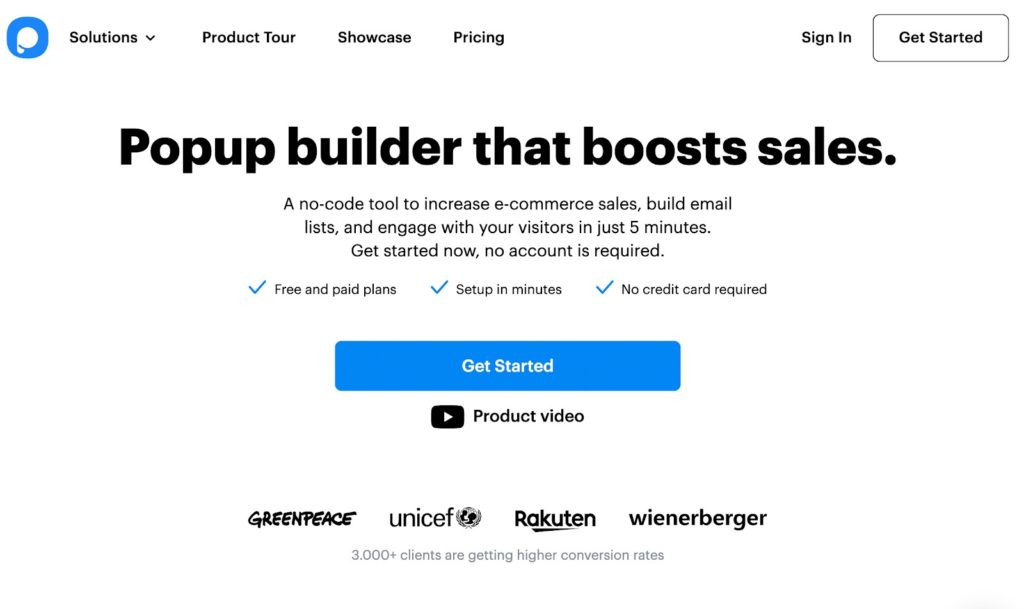
- Lets you create a simple popup for your website without having to code anything
- Offers building an email list and engaging with customers
- Recommended user-type: e-commerce businesses
Justuno
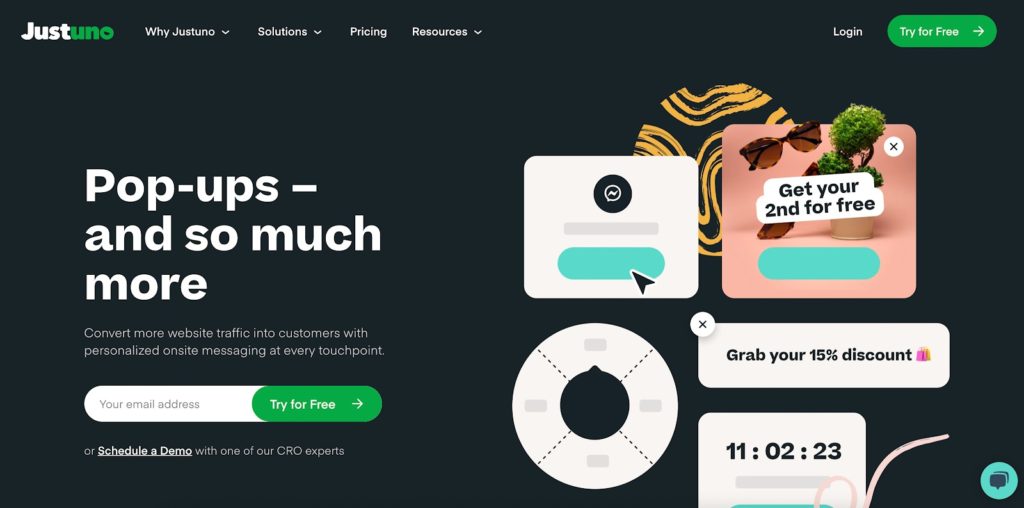
- You can enhance your site experience with Justuno's pop-ups
- Offers gamification, personalized onsite experiences as well as segmentation and targeting
- Recommended user-type: Companies with complex customer journeys and versatile ad channels
On-Page Lead generation tools
Qualaroo
- Lets you survey your visitors while they're on your website
- You can simultaneously collect feedback, get behavioral insights and generate new leads
- Recommended user-type: Companies that want to understand their customers better while getting leads
Qualaroo alternatives might offer you a better overlook of your customer satisfaction levels.
Optinmonster
- Generates you more subscribers, leads and sales from your existing traffic
- You can create a visual offer, target and personalize them and test and adjust in real time
- Recommended user-type: Businesses that already have a lot of traffic
- Optinmonster alternatives
Social proof tools
TrustPulse
- Lets you leverage and automate social proof to get you more conversions
- Several customizable notifications (purchase, analytics, conversion)
- Recommended user-type: marketing agencies, bloggers, e-commerce websites
Trustmary
- Lets you make the most out of social proof to get more leads
- Integrated feedback collection with NPS, pop-up possibilities, A/B testing to optimize, automation
- Recommended user-type: Growth companies
Here you can find 5 social proof apps to consider using in 2025.
9. FAQ about Conversion Rate
What is a good conversion rate?
A good conversion rate is one of two things:
- Better than your previous conversion rate for that period
- Better than your competitor's conversion rate
It's highly likely that you don't know if your numbers are better than your competitors, so I'd suggest focusing on your own long-term data.
What do I do with a conversion rate?
Analyze what are the reasons it looks the way it looks. If it's high (over 15%), try to keep it up and to optimize it for even better results.
If it's low (close to 0%), start optimizing your conversion rate now to get more sales.
What does conversion rate actually measure?
It measures how many people are acting the way you want them to compared to entire audience that saw your ad/app/email/website.
Conversion rate can measure, among other things, downloads of your app from the app store, sales from online shops, number of subscribers to your email list or asking for a quote.
Is 5% a normal conversion rate for an ad campaign?
It all depends on what is your normal. As conversion rates are highly variable, it's always best to compare the stats of your ad campaign to the previous campaigns you did. This way, you can start to figure out what works on which channel and what needs to be improved.
What is a bad conversion rate?
The absolute worst conversion rate is the one you don't know. Generally speaking, if your campaign, app or site aren't performing as well as they did before, those conversion rates can be considered bad.
How does conversion rate optimization work?
Once you have all the marketing data available, you look at what has worked and what hasn't. Then you focus your marketing efforts on improving those campaigns that did bad, bettering the ones that did good and enhancing your overall visitor experience to become frictionless.
When you are doing CRO successfully, you are getting more sales qualified leads and sales than before. Remember that increasing traffic isn't a great goal to have.
Why should I spend my time on conversion rate optimization?
You get more results with less effort and a lower ad spend.
If that doesn't sound good enough, you're also gaining insights on your potential and current customers which will help you improve the customer journey and to grow your revenue in the process. If that doesn't helpful, I don't know what would.
